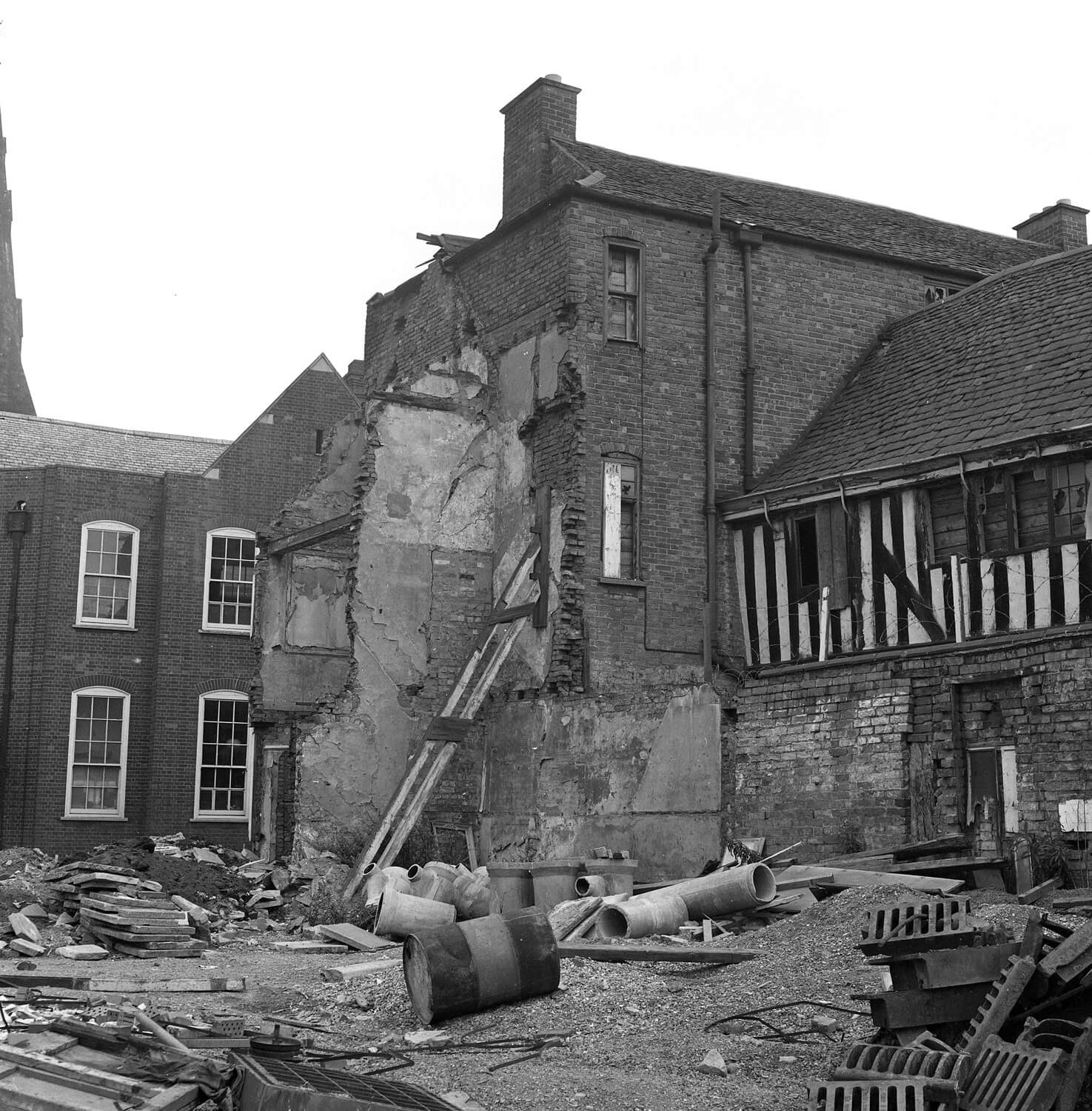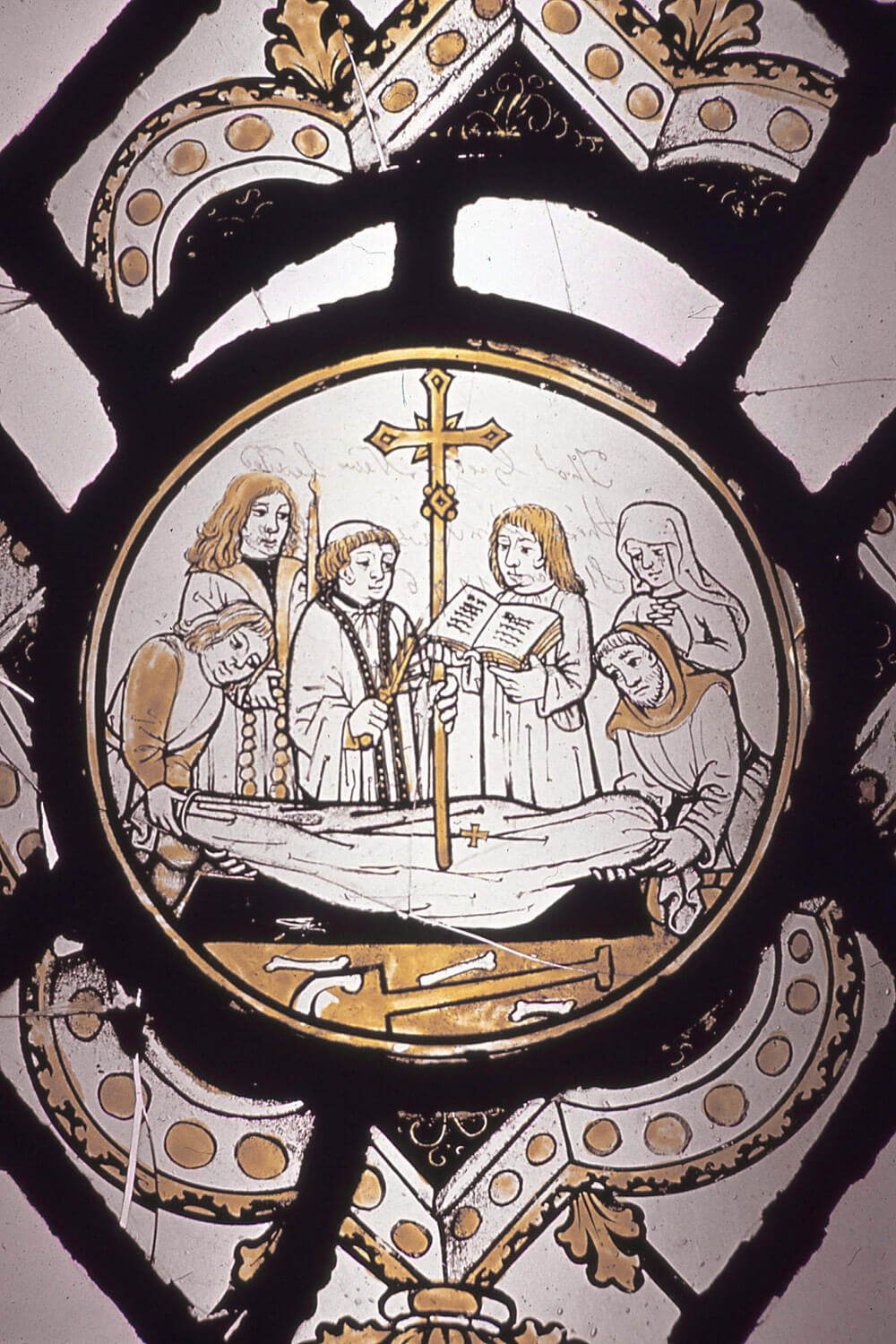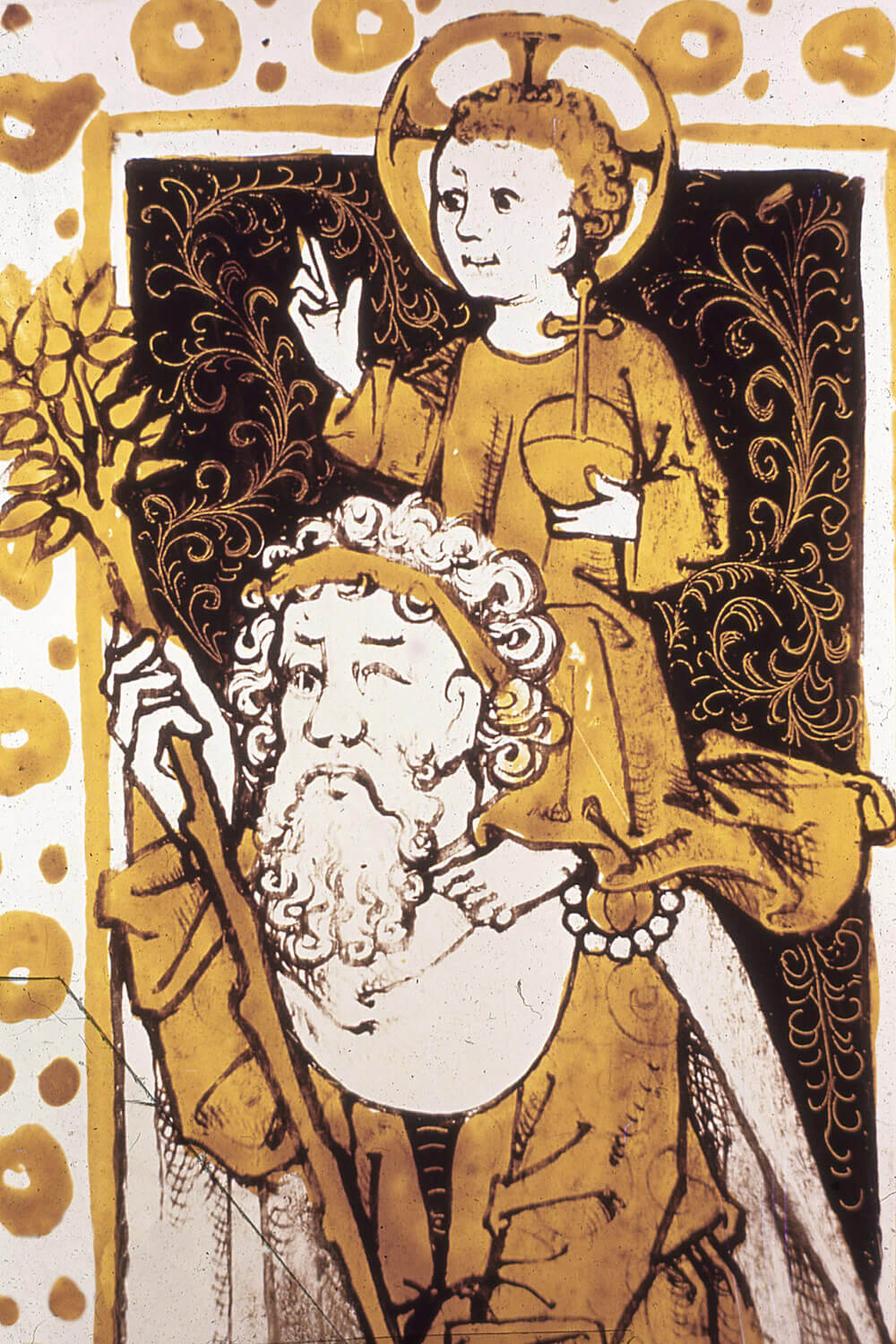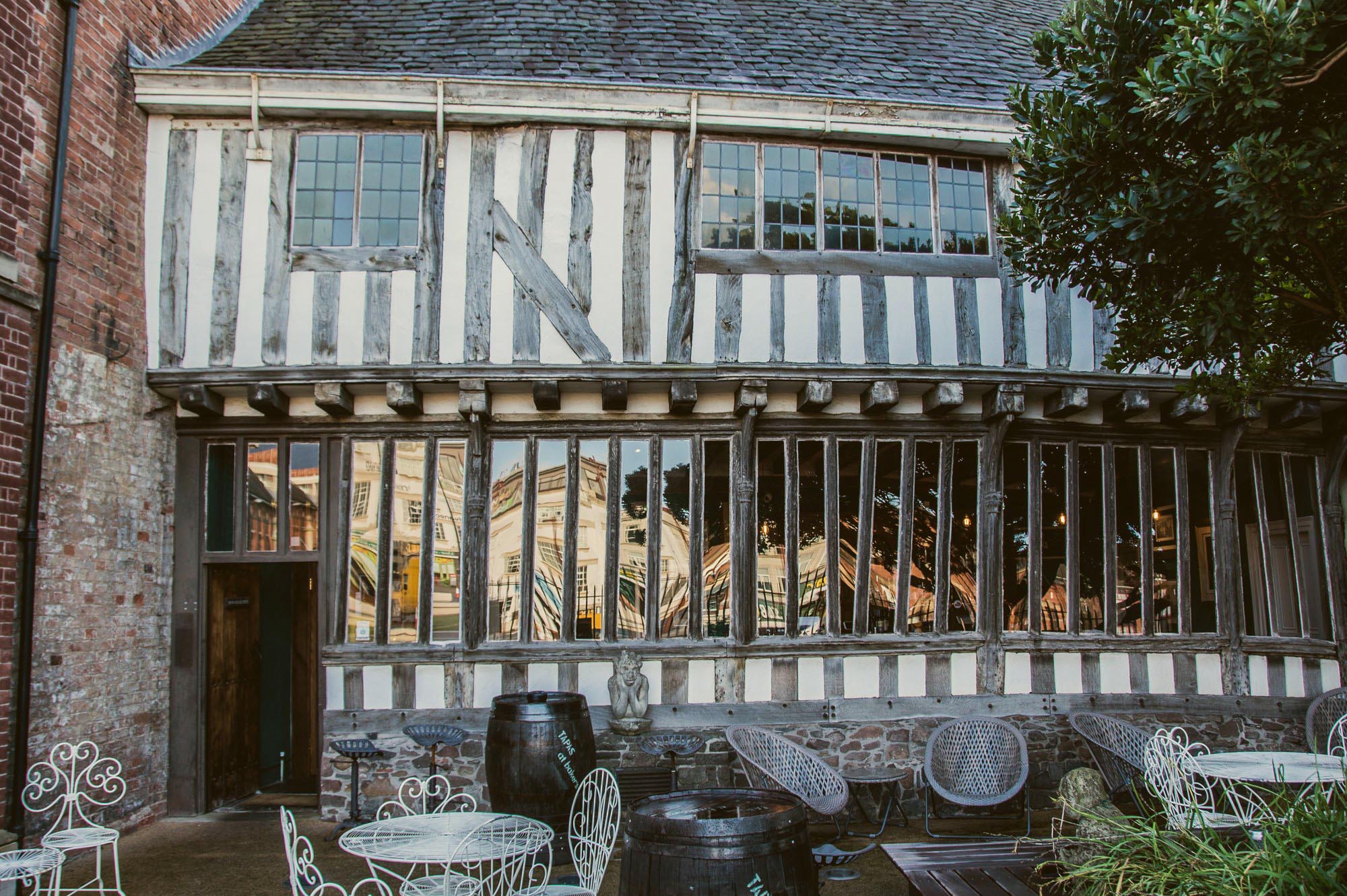- Contained ornate painted glass that is now on display at Newarke Houses
- Ownership of the house can be traced back to 1557 with a gap
- It was a costume museum for a number of years and is now a bar and restaurant
The oldest house in Leicester
Wygston’s House is the oldest house in Leicester. It has been here since medieval times and the road it stood on, High Street, was the widest and busiest thoroughfare in the town.
We don’t know why this house survives when others, which may have been significantly grander, have not. It would have been close to the meeting houses of two powerful medieval guilds, Corpus Christi and St. George, and the house may have had a religious role.
The House
The house comprises a timber hall of around 1490; a brick block of 1796 which replaced an earlier timber shop and chamber; and a Victorian (1800s) wing standing on the site of the medieval kitchen.
The oldest part of Wygston’s House, the timber-framed part, comprises a ground floor hall (living space) and upper chambers for sleeping and storage. Originally it had a shop at the front and kitchens at the rear. The upper floor of this part projects out over the ground floor, known as a jetty. At intervals there are ornamental brackets.
The front of the timber hall has a range of windows which were once filled with panels of painted glass, facing onto a courtyard. You can see a number of these glass panels dated to 1495-1500 at Newarke Houses.
Glass panels in the ground floor room, indicates the hall was the most important room, but at the end of the 1700s this room had come down in the world and was divided with one of the halves being a kitchen. Glaziers’ engravings in the glass tell us it was re-leaded in 1764 and 1796. The date and style of the glass is very similar to the fragments of glass in the Mayor’s Parlour at Leicester Guildhall close by.
The painted glass from the windows was removed by Rev. Richard Stephens who sold the house and moved the glass to his new house in Belgrave around 1824.
The upper room of the half-timbered section of the house was divided by four main upright timbers into three bays, each about 5 metres. When the house was reconstructed in the early 1970s, a tie beam was revealed. This was finished internally with laths which were plastered over with mud mixed with grit, hair and feathers. Large flat stones were wedged into slots in the sides of the vertical timbers as infilling on the outer surface, so it was probably an outside wall at one end of the building.
In the roof, rafters from either side met at the top. Each main beam across the room has two uprights or Queen posts supporting the collar beams above. Diagonal braces lie flat against the underside of the roof keeping the structure square. There was wall painting on the plaster of the north and south walls of this upper room but it is now too faint to make out.
Roger Wygston
The house may have belonged to Roger Wygston, a member of the rich and important local family who were part of Leicester’s highest faith and corporation circles in the later 1400s and early 1500s.
Roger Wygston was born about 1430. His father, William, made the family fortune from the wool trade in the first half of the 1400s. Roger was elected chamberlain in 1459 and mayor of Leicester in 1465, 1471 and 1487. He was Member of Parliament for Leicester in 1473 and 1488. He died at Whitsun 1507 and was buried in the Lady Chapel in St. Martin’s church. Roger’s nephew, William is better known to later generations of Leicester citizens. He founded Wygston’s Hospital in 1513 and his money was later used to found the Wyggeston Schools.
The initials RW intertwined appear many times in the panels of painted glass that were in the house – the W more prominent than the R - which could belong to Roger Wygston or to another rich merchant of the period, but the nature of the glass suggests association with the highest levels of Leicester’s society, which was certainly true of the Wygston family.
Ownership of Wygston’s House can be traced without a break from 1557 when Richard Chettle, constable of Leicester, owned it. It passed to his son Rafe, who became mayor of Leicester. Both men were members of St. Martin’s church. A lawyer, William Topp lived in the house in 1708, but paid rent to the Corporation and it is recorded that John Stephens was living there in 1750 and 1813, followed by the Rev. Richard Stephens.
In 1796 the east front of the building in the former High Street was taken down and a fashionable Georgian brick front added instead with an elegant doorway. After the Rev. Richard Stephens, a number of surgeons lived in the house in Victorian times: Robert Wingate, William Ashley Cox-Hippisley and William Pemberton Peake. It then became the antiques emporium of R. B. Renals & Sons. There are objects in the museum collection acquired from the emporium including a parasol and a barometer.
After restoration, Wygston’s House opened as a museum of costume in 1974. It is currently a bar and restaurant.
Gallery




Roman Leicester
(47- 500) A military fort was erected, attracting traders and a growing civilian community to Leicester (known as Ratae Corieltauvorum to the Romans). The town steadily grew throughout the reign of the Romans.
Medieval Leicester
(500 – 1500) The early years of this period was one of unrest with Saxon, Danes and Norman invaders having their influences over the town. Later, of course, came Richard III and the final battle of the Wars of the Roses was fought on Leicester’s doorstep.
-
The Castle Motte1068

-
Leicester Cathedral1086

-
St Mary de Castro1107

-
Leicester Abbey1138

-
Leicester Castle1150

-
Grey Friars1231

-
The Streets of Medieval Leicester1265

-
Leicester Market1298

-
Trinity Hospital and Chapel1330

-
Bow Bridgecirca 1350

-
Church of the Annunciation1353

-
John O’Gaunt’s Cellar1361

-
St John's Stone1381

-
Leicester Guildhall1390

-
The Magazine1400

-
The Blue Boar Inn1400

-
The High Cross1577

Tudor & Stuart Leicester
(1500 – 1700) The wool trade flourished in Leicester with one local, a former mayor named William Wigston, making his fortune. During the English Civil War a bloody battle was fought as the forces of King Charles I laid siege to the town.
Georgian Leicester
(1700 – 1837) The knitting industry had really stared to take hold and Leicester was fast becoming the main centre of hosiery manufacture in Britain. This new prosperity was reflected throughout the town with broader, paved streets lined with elegant brick buildings and genteel residences.
-
Great Meeting Unitarian Chapel1708

-
The Globe1720

-
17 Friar Lane1759

-
Black Annis and Dane Hills1764

-
Leicester Royal Infirmary1771

-
New Walk1785

-
Freemasons’ Hall1790

-
Gaols in the City1791

-
Friars Mill1794

-
City Rooms1800

-
Development of Highfields1800

-
Wesleyan Chapel1815

-
20 Glebe Street1820

-
Charles Street Baptist Chapel1830

-
Glenfield Tunnel1832

-
James Cook1832

Victorian Leicester
(1837 – 1901) The industrial revolution had a huge effect on Leicester resulting in the population growing from 40,000 to 212,000 during this period. Many of Leicester's most iconic buildings were erected during this time as wealthy Victorians made their mark on the town.
-
Leicester Union Workhouse1839

-
Campbell Street and London Road Railway Stations1840

-
The Vulcan Works1842

-
Belvoir Street Chapel1845

-
Welford Road Cemetery1849

-
Leicester Museum & Art Gallery1849

-
King Street1850

-
Cook’s Temperance Hall & Hotel1853

-
Amos Sherriff1856

-
Weighbridge Toll Collector’s House1860

-
4 Belmont Villas1862

-
Top Hat Terrace1864

-
Corah and Sons - St Margaret's Works1865

-
Kirby & West Dairy1865

-
The Clock Tower1868

-
Wimbledon Works1870

-
The Leicestershire Banking Company1871

-
St Mark’s Church and School1872

-
Victorian Turkish Baths1872

-
The Town Hall1876

-
Central Fire Stations1876

-
Aylestone Road Gas Works and Gas Museum1879

-
Gas Workers Cottages1879

-
Leicestershire County Cricket Club1879

-
Welford Road Tigers Rugby Club1880

-
Secular Hall1881

-
Development of Highfields1800

-
Abbey Park1881

-
Abbey Park Buildings1881

-
Victoria Park and Lutyens War Memorial1883

-
Leicester Fosse FC 18841884

-
Leicester Coffee and Cocoa Company Coffee Houses1885

-
St Barnabas Church and Vicarage1886

-
Abbey Pumping Station1891

-
Luke Turner & Co. Ltd.1893

-
West Bridge Station1893

-
Thomas Cook Building1894

-
The White House1896

-
Alexandra House1897

-
Leicester Boys Club1897

-
Grand Hotel and General Newsroom1898

-
Highfield Street Synagogue1898

-
Western Park1899

-
Asfordby Street Police Station1899

-
Leicester Central Railway Station1899

Edwardian Leicester
(1901 – 1910) Electric trams came to the streets of Leicester and increased literacy among the citizens led to many becoming politicised. The famous 1905 ‘March of the Unemployed to London’ left from Leicester market when 30,000 people came to witness the historic event.
-
YMCA Building1900

-
The Palace Theatre1901

-
Pares's Bank1901

-
Coronation Buildings1902

-
Halfords1902

-
High Street1904

-
George Biddles and Leicester's Boxing Heritage1904

-
Municipal Library1905

-
Leicester Boys Club1897

-
The Marquis Wellington1907

-
Guild Hall Colton Street1909

-
Women's Social and Political Union Shop1910

-
Turkey Café1901

Early 20th Century Leicester
(1910 – 1973) The diverse industrial base meant Leicester was able to cope with the economic challenges of the 1920s and 1930s. New light engineering businesses, such as typewriter and scientific instrument making, complemented the more traditional industries of hosiery and footwear manufacturing.
-
Dryad Handicrafts1912

-
De Montfort Hall1913

-
Leicester During the First World War1914

-
Fox’s Glacier Mints1918

-
Statue of Liberty1919

-
Housing in Saffron Lane1924

-
Winstanley House1925

-
Housing in North Braunstone1926

-
Lancaster Road Fire Station1927

-
The Little Theatre1930

-
Saffron Hill Cemetery1931

-
Braunstone Hall Junior School1932

-
Former City Police Headquarters1933

-
Savoy Cinema1937

-
Eliane Sophie Plewman1937
-
City Hall1938

-
Athena - The Odeon Cinema1938

-
The Blitz in Highfields1940

-
Freeman, Hardy and Willis - Leicester Blitz1940

-
Leicester Airport1942

-
Leicester’s Windrush Generations1948

-
Netherhall Estate1950
-
Housing at Eyres Monsell1951

-
Silver Street and The Lanes1960

-
Bostik1960

-
Auto-Magic Car Park (Lee Circle)1961

-
University of Leicester Engineering Building1963

-
Sue Townsend Theatre1963

-
Central Mosque1968

-
Belgrave Flyover1973

Modern Leicester
(1973 – present day) Industry was still thriving in the city during the 1970s, with the work opportunities attracting many immigrants from all over the world. While industry has declined in recent years, excellent transport links have made Leicester an attractive centre for many businesses. The City now has much to be proud of including its sporting achievements and the richness of its cultural heritage and diversity.
-
Haymarket Theatre1973

-
The Golden Mile1974

-
Acting Up Against AIDS1976

-
Belgrave Neighbourhood Centre1977

-
Diwali in Leicester1983

-
Leicester Caribbean Carnival1985

-
Samworth Brothers1986

-
Jain Centre1988

-
Guru Nanak Dev Ji Gurdwara1989

-
King Power Stadium2002

-
LCB Depot2004

-
Curve2008

-
BAPS Shri Swaminarayan Mandir2011

-
Makers Yard2012

- Roman Leicester
- Medieval Leicester
- Tudor & Stuart Leicester
- Georgian Leicester
- Victorian Leicester
- Edwardian Leicester
- Early 20th Century Leicester
- Modern Leicester
A Place to Live















































































































































